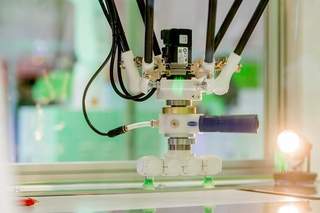
Technik Industrie Hannover Messe ©Kruppa
Trade in ICT – An Important Pillar for Economic Growth and Prosperity
Today, information and communications technology (ICT) is among the most rapidly growing sectors in world trade. According to data from the United Nations Conference on Trade and Development (UNCTAD), trade in ICT products accounted for around 12.5 percent of global merchandise exports and 13.4 percent of global merchandise imports in 2019. Data from the European Union (EU) shows that high-tech products constituted 19 percent of total extra-EU imports and 18 percent of total extra-EU exports in 2019.
At the WTO Ministerial Conference in 1996 in Singapore, a group of 29 member-states, including the then 15 EU members, concluded the Information Technology Agreement (ITA). The signatories were able to reduce import tariffs on ICT products with an annual trade value at that time of almost 500 billion U.S. dollars. The agreement covered a large spectrum of high-tech products including computers, telecommunications equipment, semiconductors, software, scientific instruments, and many of the associated components.
Lower Tariffs, Cheaper Products
This tariff reduction led to lower global prices and increased usage of modern technology. The widening circle of ITA signatories, which has now grown to 81 states, not only allows them to trade the agreed-upon ITA products tariff-free; all other WTO Members also profit from the arrangement.
On the sidelines of the WTO Ministerial Conference in December 2015 in Nairobi, 54 WTO members sealed the deal on full tariff elimination on a list of 201 further ICT goods, including new semiconductors, GPS navigation equipment, medical devices (such as ultrasound scanners), and printer accessories (such as colour cartridges), to be completed in July 2019. This tariff elimination did not apply to television equipment or miscellaneous optical components. Next to the EU member states, the United States, China, Japan, Korea and Taiwan were parties to the agreement. The expanded ITA (ITA II) covered 97 percent of global ICT merchandise trade and guaranteed tariff reduction not only for signatories, but also for other WTO members. The deal offered annual tariff savings of 13.8 billion U.S. dollars. In the future, the agreement also foresees closer cooperation to reduce non-tariff barriers, such as redundant bureaucracy. However, this is yet to be brought to life.
The BDI Position
The BDI welcomes the conclusion of the expanded ITA agreement. Concrete agreement on the reduction and avoidance of non-tariff trade barriers should follow as soon as possible. The circle of ITA members should furthermore be expanded, particularly to the larger emerging economies like Brazil (ITA), Russia (ITA II), and India (ITA II). The product list of the agreement should be regularly updated and expanded due to the fast-paced progress in this industry.
In contrast to ICT goods, trade in ICT services is underdeveloped under the current WTO regime. Under the General Agreement on Trade in Services (GATS), market access and national treatment is only guaranteed for services that are explicitly specified in lists by WTO members (the “whitelist approach”). As the 25-year-old GATS also draws on the 1991 United Nations Central Product Classification (CPC), many newly developed ICT services are not included in the service sector classification of the GATS. Thus, newer innovative ICT services often do not benefit from the already less ambitious provisions of the GATS. Given the high level of innovation of the ICT sector and the growing importance of trade in ICT services, new liberalisation steps should be sought within the WTO. The least that the WTO can do to promote ICT services trade would be to update the WTO services classification and to ambitiously liberalise the respective ICT services sectors.



